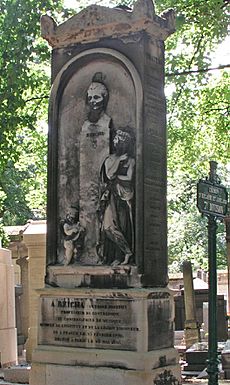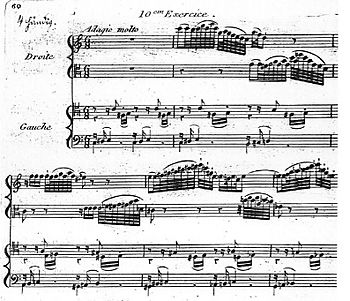Anton Reicha facts for kids
Anton Joseph Reicha (born February 26, 1770 – died May 28, 1836) was a famous composer and music theorist. He was born in what is now the Czech Republic, studied in Bavaria, and later became a French citizen.
Reicha was a friend of the well-known composer Beethoven throughout his life. Today, Reicha is best remembered for his important contributions to music for wind quintets (groups of five wind instruments). He also taught many famous students, including Franz Liszt, Hector Berlioz, and César Franck.
Besides composing, Reicha was a skilled music theorist. He wrote several books about how to compose music. Some of his ideas were very experimental, like using unusual rhythms (polyrhythm) or combining different musical keys (polytonality). However, these advanced ideas were not widely used by other composers during his time.
Reicha did not always want his music to be published. Because of this, he became less known after he died. His life and works are still being studied today.
Contents
Life Story
Early Years and Travels (1770–1805)
Anton Reicha was born in Prague. His father, who was a town musician, died when Anton was very young. His mother did not seem interested in his education. So, in 1780, when he was just 10 years old, Anton ran away from home.
He first visited his grandfather, then went to live with his uncle, Josef Reicha. Josef was a talented cellist, conductor, and composer. Since Josef and his wife had no children, they gave Anton a lot of attention. Josef taught him to play the violin and piano. His wife made sure he learned French and German, and he also learned the flute.
In 1785, the family moved to Bonn. There, Reicha joined the court orchestra, playing violin and flute. In 1789, a young Beethoven also joined the orchestra, and he and Reicha became good friends. They likely studied composition together.
Reicha secretly studied composition against his uncle's wishes. He composed and conducted his first symphony in 1787. He also attended the University of Bonn from 1789 until 1794. In 1794, French troops attacked Bonn, and Reicha escaped to Hamburg. He decided he would no longer perform in public. Instead, he taught music and continued to compose. He also studied mathematics and philosophy.
In 1799, he moved to Paris, hoping to become a successful opera composer. But his operas were not accepted, so he moved to Vienna in 1801.
In Vienna, he studied with famous teachers like Antonio Salieri and Johann Georg Albrechtsberger. He also reconnected with Beethoven. This time in Vienna was very productive for Reicha. He wrote many works, including his 36 Fugues for piano (dedicated to Joseph Haydn) and a teaching book called Practische Beispiele.
Life in Paris (1806–1836)
Reicha's time in Vienna was interrupted when Napoleon's troops occupied the city in 1805. In 1806, Reicha traveled to Leipzig, but he couldn't return to Vienna for several months. By 1808, Austria was preparing for another war, so Reicha decided to move back to Paris.
In Paris, he started teaching composition privately. His fame as a teacher and theorist grew. By 1817, many of his students became professors at the Conservatoire de Paris (Paris Conservatory). In 1818, Reicha himself became a professor of counterpoint and fugue at the Conservatory.
During this time in Paris, Reicha wrote important books on music theory. His Cours de composition musicale (Course of Musical Composition) became a standard textbook at the Conservatory. He also started composing his 25 wind quintets. These pieces are his most famous works today. They were less experimental than some of his earlier music. But they helped wind instrument players improve their skills and expanded what was possible for wind ensembles.
In 1818, he married Virginie Enaust, and they had two daughters. He continued to teach many students, including Louise Farrenc.
Reicha lived in Paris for the rest of his life. He became a French citizen in 1829. In 1835, he received the Legion of Honour, a high award in France. That same year, he joined the Académie française, a famous French institution. He published more large books on advanced composition and writing opera.
From 1826, famous composers like Franz Liszt, Hector Berlioz, and César Franck became his students. Berlioz praised Reicha as an "admirable teacher." Reicha died in May 1836 and was buried in the Père Lachaise Cemetery in Paris.
Musical Works
It can be tricky to list all of Reicha's works because some were lost, and many were published multiple times. He wrote music in many different styles, from operas to piano fugues.
He is most famous for his 25 wind quintets, written in Paris between 1811 and 1820. These pieces were very popular and were played all over Europe. Reicha said that there wasn't much good music for wind instruments at the time. His experience as a flautist helped him write these pieces. He explored what the wind instruments could do and made the music challenging but fun to play.
Reicha's wind quintets helped improve the skills of wind players. He combined difficult technical parts with popular melodies. He also included his academic interests in variations and counterpoint. Some of his quintets even have musical ideas from Beethoven's symphonies.
Reicha also wrote very advanced pieces to show his theoretical ideas. For example, his 36 Fugues for piano (1803) explored new ways to write fugues. He used unusual rhythms and time signatures, some inspired by folk music. He even included subjects (main melodies) from famous composers like Haydn, Bach, and Mozart.
His Études dans le genre fugué (Studies in the Fugue Style), published around 1817, were also very advanced. Each piece came with Reicha's advice for young composers. His large set of variations, L'art de varier (The Art of Variation), also showed off many new ideas.
Many of Reicha's string quartets were also very advanced. They influenced the quartets of Beethoven and Schubert. Reicha wrote for many other groups of instruments too, including violin sonatas, piano trios, and works for voice. He also composed larger works like at least eight symphonies, seven operas, and choral pieces like a Requiem.
Much of Reicha's music was not published or performed during his lifetime. He once said that he preferred to stay at his desk composing rather than spending time trying to get his music performed. He also had ideas, like using quarter tones (notes between the usual notes), that were too new for people to understand at the time.
Writings
Reicha wrote several important books on music theory and teaching:
- Practische Beispiele (Practical Examples) (1803): This book included 25 very difficult exercises for sight-reading music. Some of these exercises explored complex rhythms and different musical keys.
- Traité de mélodie (Treatise on Melody) (Paris, 1814): This book was about how to write melodies.
- Cours de composition musicale, ou Traité complet et raisonné d'harmonie pratique (Course of Musical Composition) (1818): This became the standard textbook for composition at the Paris Conservatory.
- Traité de haute composition musicale (Treatise on Advanced Musical Composition) (2 vols., 1824–1826): In this book, Reicha shared some of his most daring ideas, like using quarter tones and folk music.
- L'art du compositeur dramatique (The Art of the Dramatic Composer) (4 vols., 1833): This book was about how to write operas. It included many examples from his own operas.
He also wrote smaller texts, including an outline of his new system for writing fugues.
Notable Recordings
- Complete Wind Quintets (1990). The Albert Schweitzer Quintet. 10 CDs, CPO, 9992502
- 36 Fugues Op. 36 (1991–1992). Tiny Wirtz (piano). 2 CDs, CPO 999 065-2
- Complete Wind Quintets (2005-2012). The Westwood Wind Quintet. 12 CDs, Crystal Records, CD260
- 36 Fugues (2006). Jaroslav Tůma (fortepiano Anton Walter, 1790). 2 CDs, ARTA F101462
- Complete Symphonies (2011). Ondřej Kukal conducting Prague Radio Symphony Orchestra. 2 CDs, Radioservis, CR0572-2
- Musique de Chambre (2017). Solistes de la Chapelle Musicale Reine Elisabeth. 3 CDs, ALPHA369
- Reicha Rediscovered, Volume 1 (2017). Ivan Ilić (piano). 1 CD, CHAN 10950
- Reicha Rediscovered, Volume 2, Études dans le genre Fugué, Op.97 Nos 1-13 (2018). Ivan Ilić (piano). 1 CD, CHAN 20033
- Reicha Rediscovered, Volume 3, L'Art de varier ou 57 variations pour le piano, Op. 57 (2021). Ivan Ilić (piano). 1 CD, CHAN 20194
See also
 In Spanish: Anton Reicha para niños
In Spanish: Anton Reicha para niños




